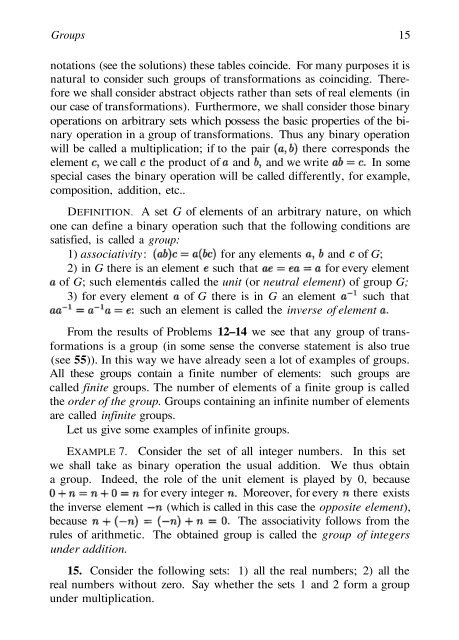Abel's theorem in problems and solutions - School of Mathematics
Abel's theorem in problems and solutions - School of Mathematics
Abel's theorem in problems and solutions - School of Mathematics
Create successful ePaper yourself
Turn your PDF publications into a flip-book with our unique Google optimized e-Paper software.
Groups 15<br />
notations (see the <strong>solutions</strong>) these tables co<strong>in</strong>cide. For many purposes it is<br />
natural to consider such groups <strong>of</strong> transformations as co<strong>in</strong>cid<strong>in</strong>g. Therefore<br />
we shall consider abstract objects rather than sets <strong>of</strong> real elements (<strong>in</strong><br />
our case <strong>of</strong> transformations). Furthermore, we shall consider those b<strong>in</strong>ary<br />
operations on arbitrary sets which possess the basic properties <strong>of</strong> the b<strong>in</strong>ary<br />
operation <strong>in</strong> a group <strong>of</strong> transformations. Thus any b<strong>in</strong>ary operation<br />
will be called a multiplication; if to the pair there corresponds the<br />
element we call the product <strong>of</strong> <strong>and</strong> <strong>and</strong> we write In some<br />
special cases the b<strong>in</strong>ary operation will be called differently, for example,<br />
composition, addition, etc..<br />
DEFINITION. A set G <strong>of</strong> elements <strong>of</strong> an arbitrary nature, on which<br />
one can def<strong>in</strong>e a b<strong>in</strong>ary operation such that the follow<strong>in</strong>g conditions are<br />
satisfied, is called a group:<br />
1) associativity : for any elements <strong>and</strong> <strong>of</strong> G;<br />
2) <strong>in</strong> G there is an element such that for every element<br />
<strong>of</strong> G; such element is called the unit (or neutral element) <strong>of</strong> group G;<br />
3) for every element <strong>of</strong> G there is <strong>in</strong> G an element such that<br />
such an element is called the <strong>in</strong>verse <strong>of</strong> element<br />
From the results <strong>of</strong> Problems 12–14 we see that any group <strong>of</strong> transformations<br />
is a group (<strong>in</strong> some sense the converse statement is also true<br />
(see 55)). In this way we have already seen a lot <strong>of</strong> examples <strong>of</strong> groups.<br />
All these groups conta<strong>in</strong> a f<strong>in</strong>ite number <strong>of</strong> elements: such groups are<br />
called f<strong>in</strong>ite groups. The number <strong>of</strong> elements <strong>of</strong> a f<strong>in</strong>ite group is called<br />
the order <strong>of</strong> the group. Groups conta<strong>in</strong><strong>in</strong>g an <strong>in</strong>f<strong>in</strong>ite number <strong>of</strong> elements<br />
are called <strong>in</strong>f<strong>in</strong>ite groups.<br />
Let us give some examples <strong>of</strong> <strong>in</strong>f<strong>in</strong>ite groups.<br />
EXAMPLE 7. Consider the set <strong>of</strong> all <strong>in</strong>teger numbers. In this set<br />
we shall take as b<strong>in</strong>ary operation the usual addition. We thus obta<strong>in</strong><br />
a group. Indeed, the role <strong>of</strong> the unit element is played by 0, because<br />
for every <strong>in</strong>teger Moreover, for every there exists<br />
the <strong>in</strong>verse element (which is called <strong>in</strong> this case the opposite element),<br />
because The associativity follows from the<br />
rules <strong>of</strong> arithmetic. The obta<strong>in</strong>ed group is called the group <strong>of</strong> <strong>in</strong>tegers<br />
under addition.<br />
15. Consider the follow<strong>in</strong>g sets: 1) all the real numbers; 2) all the<br />
real numbers without zero. Say whether the sets 1 <strong>and</strong> 2 form a group<br />
under multiplication.

















